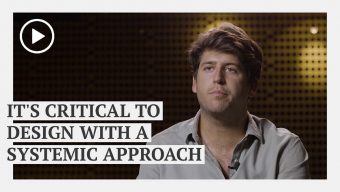“As family owners, we always said the leader doesn’t just lead in a closed company. They have two roles. One was to run the company, and the other was to play an active role in society.” – Johan Andresen, 5th generation family owner
In 1969, John Rockefeller surprised his audience at a congressional hearing by calling on private actors to engage in “venture philanthropy,” a practice that he described as “the imaginative pursuit of less conventional charitable purposes than those normally undertaken by established public charitable organizations.” The millionaire’s plea for a more rigorous look at philanthropic giving came from the realization that traditional “good deeds” needed to be reformed in order to see true change in society.
Many years later, in 2007, the Rockefeller Foundation gathered leaders from the financial and philanthropic sectors, including those in asset management and social enterprise, to explore new ways of investing at the intersection between the business and the social sector. This time around, the call was to contribute to societal changes not only through philanthropy but through financial investments in projects that would generate a measurable social or environmental impact alongside a financial return. The term “impact investing” was born.
Venture philanthropy and impact investing have now become common parlance. Yet, it’s easy to forget the fact that these concepts were first introduced not by government, nor by a development agency or even NGOs, but by a business family. Business families, especially those of particular prominence, are often best remembered for their economic role as the owners and creators of those well-known household brands that have become a habitual part of our daily lives (Ford, Heineken, Kraft Heinz, Ferrero, Walmart, Nike, and in Spain: Mercadona, El Corte Ingles, just to name a few.) However, many of these businesses have also played an important role in the philanthropic realm and have backed social impact projects for decades and even some for centuries.
It is also important to understand the difference between a business family and a family business, particularly in how it relates to philanthropy and impact investing. Busines families are best defined as a group of family members managing a joint patrimony currently or historically tied to a company. While many families have sold the original family firm generations ago, they still continue to manage assets together. From a social impact perspective, this means that business families are not limited to corporate social responsibility and corporate philanthropy but may engage in social impact from a wider range of vehicles, such as a family foundation or a family office.
Business families are the opposite of “faceless owners” and the family is often clearly linked to the image of the business.
This vantage point, unique in the market, may explain why business families have pioneered a new set of practices, which we broadly refer to as “impact investing” but actually include a range of funding practices. For example, there is engaged grant-making and venture philanthropy (in which philanthropic donations are selected and managed in the same way as venture capital, i.e. with an active measurement of the social impact generated), ESG investing (also known as sustainable & responsible investing and is essentially traditional investment based on environmental, social, and governance considerations but without an active measurement of the impact generated), and lastly, actual impact investing (a specific financial practice aiming at generating a measurable social impact alongside a financial return.)
Of course, the question is why do some of these business families choose to pursue impact investing? While impact investing practices (including venture philanthropy and ESG investing) are in response to similar logic, different investors adopt them for different reasons. Likewise, research I conducted with IE Business School’s Cristina Cruz and Rachida Justo, “Engaging in a new field: Business-owning families’ differential approach to impact investing,” suggests that business families also differ in their motivations and ways to engage in this new field.
Business families may engage in impact investing in order to scale up a long-lasting tradition of philanthropy. It is for good reason that business families are often called “natural philanthropists” – they are, in fact, responsible for a very large part of the philanthropic and charitable actions conducted around the world. As an illustration, in the Forbes list of “25 Most Philanthropic Billionaires,” we recognize the Dell family, but also the Lauder family and the Koch family at the head of America’s largest private company.
As business families grow and mature, there is the desire to expand and progress their philanthropic endeavors. Many families with a legacy of charity have engaged in venture philanthropy as a way to introduce business acumen into their donations. For example, countless business families took part in the young days of microfinance, providing low-interest or interest-free loans to micro-entrepreneurs on the ground and reinvesting the recovered capital and potential interests back into the field. As Margot Brandenburg of the Ford Foundation (and formerly of the Rockefeller Foundation) commented, “We realized that charitable grantmaking was not nearly as significant as it had been 75 years ago. These resources were a drop in the bucket compared to the challenges we cared about and wanted to influence, and we needed to focus not only on charitable giving and government resources leverage but also on the enormous power of international capital markets.”
Other families may have a vision for the future entrepreneurial and financial landscape. These families tend to see impact investing as a way to pioneer new ways of doing finance and get ahead of their competition. As a result, they are more likely to opt for direct impact investing and put equity into promising start-ups that have a tangible social or environmental impact – so long, of course, that they also show a strong potential for growth and financial return. This is made possible through the freedom of movement enjoyed by these investors when it comes to managing their assets, as capital is generally concentrated in the hands of the family. As Camilla Hagen Sørli, of family-owned investment company Canica, explained, “Investing in greener innovations is also about reducing risks and realizing the opportunities that lie in front of us. […] History has taught us that the most successful companies are those that took corporate responsibility and became engaged in their surroundings and society as a whole. Profit and being responsible opposites, research shows that combining responsibility with innovation results in better performance.”
Impact investing can also be used as a tool for business families to maintain and protect their reputations. Business families are the opposite of “faceless owners” and the family is often clearly linked to the image of the business. Thus, as research has shown, these business families are more likely to focus on their reputation and use impact investing as a tool to shield themselves as they come under greater scrutiny than those business owners who are less easily associated with their firm. ESG investing is often a practice of choice for these families as it sends a positive message to the general public about their values and commitment to society while requiring minimum efforts compared to other forms of impact investing. In the UBS Global Family Office Report from last year, a chief investment officer mentioned, “We don’t have a mandate for ESG, but it’s not rocket science to look at the change in consumer demand and the political and social environment […] it’s important now in the public eye and in the consumer’s eye. It’s something that we can’t just brush over because people are only going to pay more and more attention to it, and governments are only going to pay more and more attention to it.”
Starting with the Rockefellers, business families have long been key in creating and building the field known today as impact investing – and they will continue to be its champions. They are, in fact, well poised to take the lead on further evolving the trend from philanthropy to a greater alignment of financial returns with social and environmental impact, particularly as each new generation takes the reins. Millennials and Generation Z have come to expect the business and financial sector to be accountable and to promote social change. Business families – given their focus on purpose and legacy and their unique structure that enables relatively quick equity-based decision making – are primed to live up to this expectation and not only push impact investment forward but to lead in such a way that other businesses can follow their example.
© IE Insights.








